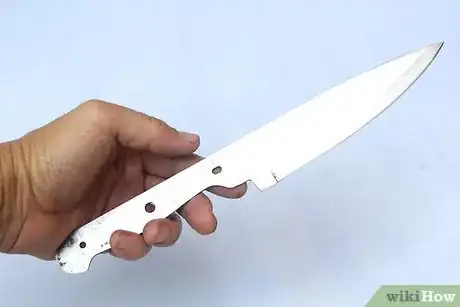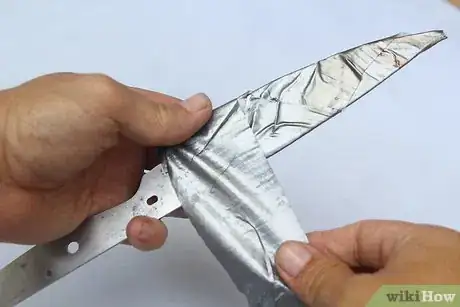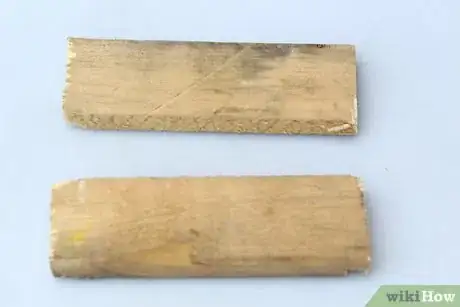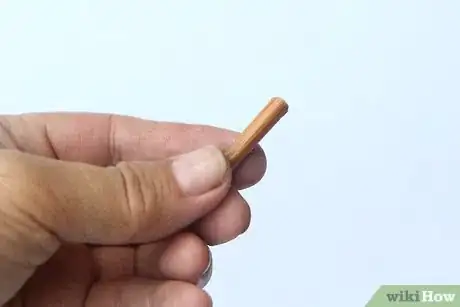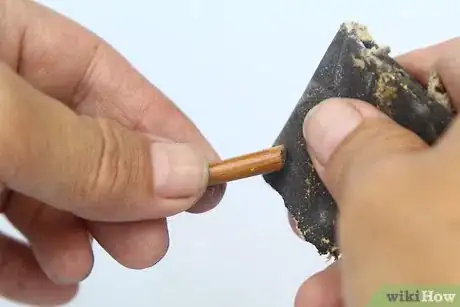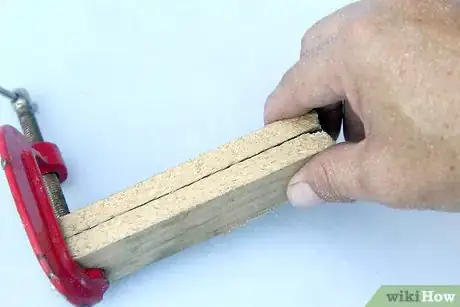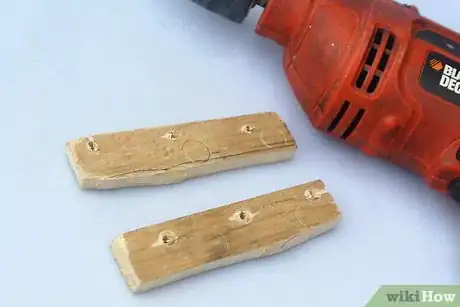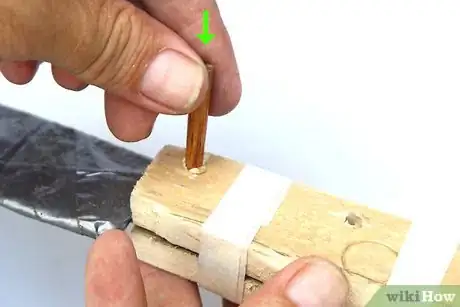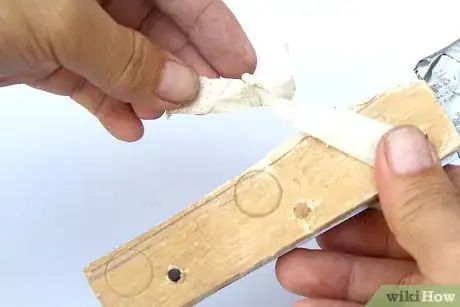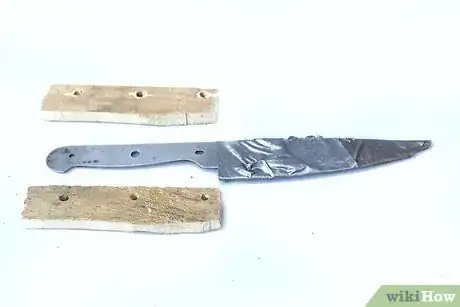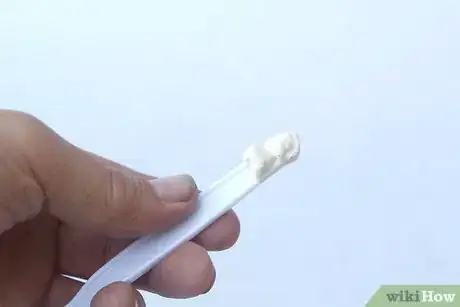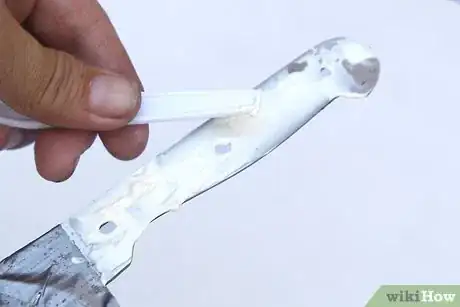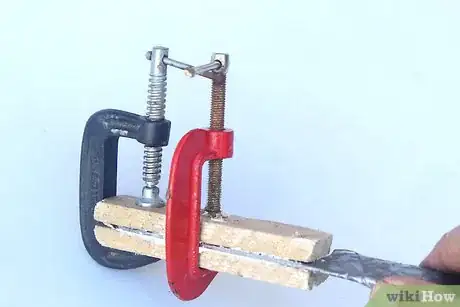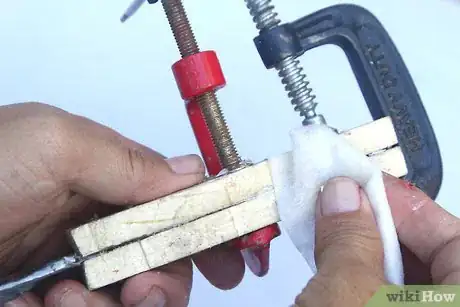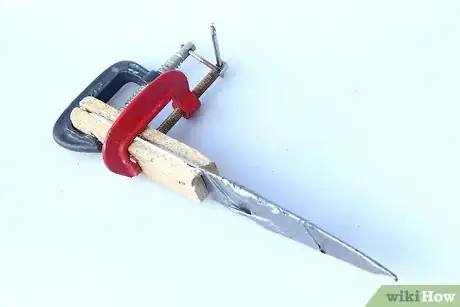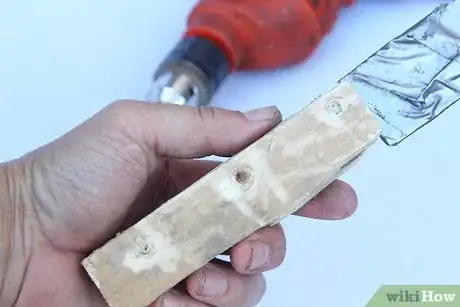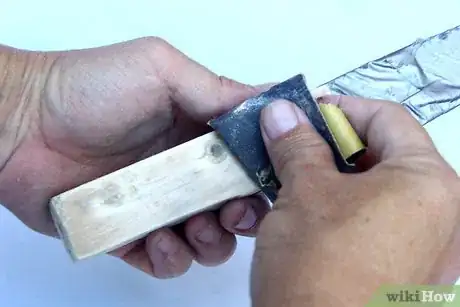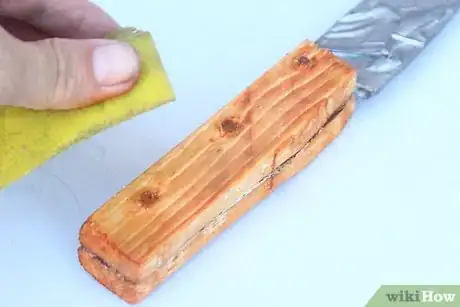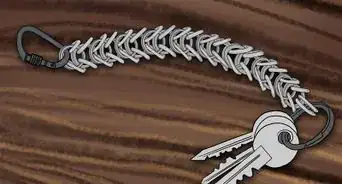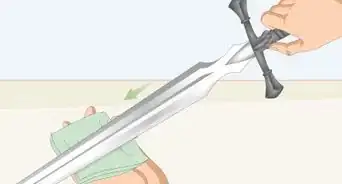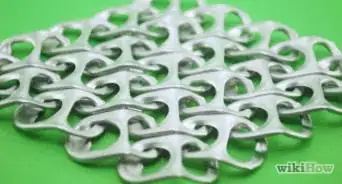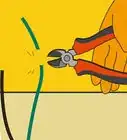X
This article was co-authored by wikiHow Staff. Our trained team of editors and researchers validate articles for accuracy and comprehensiveness. wikiHow's Content Management Team carefully monitors the work from our editorial staff to ensure that each article is backed by trusted research and meets our high quality standards.
There are 15 references cited in this article, which can be found at the bottom of the page.
This article has been viewed 77,043 times.
Learn more...
There is a certain beauty to handmade knife handles. The process of making custom knife handles may take a while, but it is easy once you know what to do. Best of all, you can have a beautiful custom knife to show off at the end.
Things You Should Know
- You can make an easy DIY knife handle using two blocks of wood.
- Cut the wood to the right size for your knife handle, then glue the blocks in place.
- Sand and seal the handle for a smooth, beautiful finish.
Steps
Part 1
Part 1 of 4:
Preparing the Base and Materials
-
1
-
2Wrap 3 layers of tape around the blade part of your knife. Duct tape or electrical tape will work the best. You can use masking tape, but you'll need to use more layers. Wrap the tape from the tip of the knife all the way down to the base, where the blade ends. Do not cover the tang.[2]
- Make sure that the tape completely covers the blade. This will reduce the chances of the knife cutting you, or of epoxy getting on the blade.
- The tape will not only keep you from getting cut while you work, but also protect the blade from getting chipped or scratched.
- If you can still feel the blade through the tape, simply wrap more tape around the blade.
Advertisement -
3Find two 1⁄4-in (0.64-cm) pieces of wood for the scales. Choose a strong, durable wood that is about 1⁄4-in (0.64-cm) thick, and a little larger than the tang. For a nicer finish, ensure that the grain runs along the length of the wood. You can buy these pieces online from stores that specialize in knife-making supplies.[3]
- A knife handle is composed of 2 halves, which are also known as "scales." The tang is sandwiched between the scales.
- Great types of wood to work with include: apple, ash, bois d'arc, hickory, peach, pear, and pecan.[4]
- Hardwoods come from deciduous trees and are typically more durable than softwoods, which come from coniferous trees.[5]
-
4Cut the pins, if needed. If you purchased a knife kit, the pins may already be cut for you. If you didn't purchase a kit, you will need to cut the metal rod into 1 in (2.5 cm) lengths. Set the rod down on a stable surface, then use a metal saw or file to cut it into 1 in (2.5 cm) lengths.[6]
- How many rods you cut depends on how many holes are in the tang. Some knives have 2 holes while others have 4.
- The metal rod needs to be thin enough to fit through the holes in the tang. The thickness of the rod varies from knife to knife.
-
5File down the ends of the pins, if needed. Once again, if you purchased a kit, the pins should already be filed down for you. If you cut the pins yourself, there will likely be sharp burs on each end. File these down using a metal file or grinder.[7]
- Don't worry if the ends of the pins are not perfectly flat. You will be filing them down later so that they are flush with the scales.
-
6Line your vise or clamps with plywood and plastic wrap. You won't be using this until you are ready to glue everything together. Epoxy glue sets quickly, however, so it would be a good idea to have everything ready. Attach a piece of plywood to each side of your vise. Fold a sheet of plastic wrap, then tuck it between the vises, like a taco.[8]
- Use a heavy-duty table-mounted vise, if possible. If you don't have that, use 2 to 3 smaller vises instead.
- The plywood will protect the wooden scales from getting dented by the vises.
- The plastic wrap will keep the epoxy glue from getting everywhere. If you don't have that, you can try wax paper instead.
Advertisement
Part 2
Part 2 of 4:
Drilling the Pin Holes
-
1Tape the scales and tang together. Stack the scales together with the sides you want to be on the outside of the handle facing out. Set the tang on top, then wrap a piece of masking tape around the middle to hold everything together.
- Be careful not to cover the holes in the tang. If the scales and tang wobble, wrap a second piece of tape around the end of the tang and scales.
- Masking tape will work the best here because it has a strong hold but leaves little residue.
-
2Use a drill press to make the first hole using the tang's holes as a guide. Set the knife down on your drill plate, with the tang facing up. Insert the drill bit into 1 of the holes in the tang. Start the drill and press down on it, making sure to go through both scales. Stop the drill press and lift the bit out.
- You may find this easiest to do with a drill press, but a handheld drill may do the job.
-
3Insert a pin into the hole, then do the remaining holes. If your tang has 4 holes in it instead of 2, drill the second hole diagonal from the first. Insert the pin, then drill the remaining 2 holes, working diagonally. Insert the pins as soon as you finish the holes.[9]
- Drilling the holes and inserting the pins 1 at a time will further reduce the chances of the tang and scale from shifting.
- Use a hammer to tap the pins in.
-
4Remove the tape and trace the tang onto the scales. Peel the piece of tape off, but leave the pins and tang in place. Trace around the tang with a marker.[10]
- It does not matter if you use a washable or permanent marker. You will eventually sand this off.
-
5Remove the tang and cut the scales. Lift the tang away, but leave the pins inside the scales. Use a band saw or a scroll saw to cut the scales just outside the line that you traced. You will sand the scales to fit the tang later.[11]
- You are cutting through both scales at the same time. The pins will hold the scales together.
-
6Sand and polish the top edge of the scales. After you assemble the knife handle, you won't be able to sand and polish the top narrow edge that touches the base of the blade. The blade will get in the way, so it's best to do this now. Simply tape the scales together, then sand and polish the top edge as desired.[12]
- Use a belt sander to shape the edge. Sand the edge down with 220- and 400-grit sandpaper. Finish off with a buffer.
- It would be an even better idea to insert the pins into the scales. This will ensure that the scales are aligned and symmetrical.
Advertisement
Part 3
Part 3 of 4:
Gluing the Scales
-
1Clean the tang on both sides to remove any oils or dirt. You can use window cleaner or rubbing alcohol. Simply wipe the tang down with your desired solution, and let it dry. Be careful not to handle the tang with your bare hands after this.[13]
- Rubbing alcohol will work the best, but you can use window cleaner too.
- You don't have to clean the wood scales. The wood is porous and textured, so it will take the epoxy readily.
-
2Scuff the tang on both sides to give the epoxy some texture to stick to. You can do this with a metal file or even a screw. You don't have to be precise for this step, but you should wipe the surface down once you are done.[14]
- If the scales are smooth on the marked sides, it would be a good idea to scuff them as well.
- You can also roughly sand the scales with 120-grit sandpaper. Make sure that you are only sanding the sides that will be touching the tang.[15]
-
3Prepare the epoxy glue according to the instructions. Each brand of epoxy glue is different, but in most cases, you will need to mix equal amounts of "Part A" and "Part B" in a plastic, disposable cup. Work quickly. Most epoxy glues set within minutes.[16]
- Make sure that you are using epoxy glue, and not epoxy resin or coating.
- Mix the epoxy using a disposable tool, as it will ruin whatever you use to stir it. It would be a good idea to wear some plastic of vinyl gloves too.
- You can buy epoxy glue in hardware stores. Some craft stores may also sell epoxy glue.
-
4Glue the first scale to the the tang with the prepared epoxy. Use a disposable knife or paint spatula to spread an even layer of epoxy onto 1 side of the tang and the marked side of the matching scale with epoxy. Press the 2 together.[17]
-
5Insert the pins and glue the second scale. Working quickly, flip the knife over so that you can see the other side of the tang. Insert the pins into the holes. Coat the tang and the marked side of the remaining scale, and press them together.[18]
- You may have to hammer the second scale into place to ensure a tight fit.
- If you want to, you can coat the pins with epoxy too. This will make the bond even stronger.[19]
-
6Insert the handle into the vise and clamp it shut. Make sure that you are inserting the handle between the pieces of plastic wrap--this way, the excess epoxy won't get everywhere. Close the vise as tightly as possible.[20]
-
7Wipe off any excess epoxy with a rag soaked in acetone. After squeezing the 2 halves together, all the excess epoxy will have leaked out. Dip a rag in acetone, and use it to wipe off any epoxy that has leaked out from between the 2 scales.[21]
-
8Allow the epoxy to set. How long this takes depends on the type of epoxy you are using. Some are set and ready to use within 1 hour. Others need up to 1 day to dry. Check the label on your package of epoxy for complete drying times and instructions.
Advertisement
Part 4
Part 4 of 4:
Finishing the Handle
-
1Take the knife out of the vise. Once the epoxy has set, undo the vise and pull the knife out. Do not remove the tape from the blade just yet.
-
2Grind off the excess pins, if needed. Use a belt sander or grinder to remove any excess pins that are sticking out of the surface of the scale. You want them to be flush with the scale.[22]
-
3Carve and shape the handle with a belt sander. Keep sanding the scales until you reach the metal part of the tang. If you have any lines leftover from when you traced the tang onto the scales, be sure to sand that off too. At this point, you can also sand the edges of the handle so that they are more rounded and comfortable to hold.[23]
-
4Sand and polish the scales. Begin sanding the scales with 220-grit sandpaper. Once the wood is smooth, move onto 400-grit sandpaper. Finish off with a buffer until the scales are polished to your liking.[24]
-
5Seal the handle, if desired. For an even nicer finish, you can apply 1 coat of de-waxed shellac and 2 coats of an oil-based polyurethane sealer. Buff the finish after it dries. How long the finish takes to dry depends on the brand that you are using, so read the label carefully. This can take anywhere from a few hours to a few days.[25]
-
6Remove the tape from the blade. Your knife is now complete and ready to use. If you notice any epoxy on the blade, you can scrape it off with a craft blade, but make sure that you go along the length of the blade. You can also try dissolving it with acetone.
Advertisement
Things You'll Need
- Full-tang knife blade
- 2 1⁄4-in (0.64-cm) thick wood piece
- Metal pins (or metal rod and saw/file)
- Vise and plywood planks
- Drill press (or handheld drill)
- Belt sander or drum sander
- Rubbing alcohol or window cleaner
- Old rag and acetone
- 120-, 220-, and 400-grit sandpaper
- Wood buffer
- De-waxed shellac and oil-based polyurethane sealer (optional)
- Plastic wrap or wax paper
- Duct tape or electrical tape
- 2-part epoxy glue (not resin)
- disposable cup and stir stick (for epoxy)
References
- ↑ https://www.woodcraft.com/blog_entries/get-a-handle-on-knife-making-and-stay-sharp
- ↑ http://www.woodworkersjournal.com/make-a-wood-knife-handle/
- ↑ http://www.woodworkersjournal.com/make-a-wood-knife-handle/
- ↑ http://www.jayfisher.com/Handles_Knife_Woods.htm
- ↑ http://knifeinformer.com/the-ultimate-guide-to-knife-handle-materials/
- ↑ https://www.youtube.com/watch?v=ltUdwrBJFSc&feature=youtu.be&t=20s
- ↑ https://www.youtube.com/watch?v=ltUdwrBJFSc&feature=youtu.be&t=22s
- ↑ https://www.youtube.com/watch?v=ltUdwrBJFSc&feature=youtu.be&t=8m10s
- ↑ https://www.youtube.com/watch?v=ltUdwrBJFSc&feature=youtu.be&t=4m10s
- ↑ https://www.woodcraft.com/blog_entries/get-a-handle-on-knife-making-and-stay-sharp
- ↑ https://www.woodcraft.com/blog_entries/get-a-handle-on-knife-making-and-stay-sharp
- ↑ https://www.woodcraft.com/blog_entries/get-a-handle-on-knife-making-and-stay-sharp
- ↑ https://www.youtube.com/watch?v=ltUdwrBJFSc&feature=youtu.be&t=9m30s
- ↑ https://www.youtube.com/watch?v=ltUdwrBJFSc&feature=youtu.be&t=10m
- ↑ https://www.woodcraft.com/blog_entries/get-a-handle-on-knife-making-and-stay-sharp
- ↑ https://www.youtube.com/watch?v=ltUdwrBJFSc&feature=youtu.be&t=11m20s
- ↑ https://www.youtube.com/watch?v=ltUdwrBJFSc&feature=youtu.be&t=14m
- ↑ https://www.youtube.com/watch?v=ltUdwrBJFSc&feature=youtu.be&t=14m50s
- ↑ https://www.woodcraft.com/blog_entries/get-a-handle-on-knife-making-and-stay-sharp
- ↑ https://www.youtube.com/watch?v=ltUdwrBJFSc&feature=youtu.be&t=16m30s
- ↑ https://www.woodcraft.com/blog_entries/get-a-handle-on-knife-making-and-stay-sharp
- ↑ https://www.youtube.com/watch?v=ltUdwrBJFSc&feature=youtu.be&t=16m23s
- ↑ https://www.woodcraft.com/blog_entries/get-a-handle-on-knife-making-and-stay-sharp
- ↑ https://www.woodcraft.com/blog_entries/get-a-handle-on-knife-making-and-stay-sharp
- ↑ http://www.woodworkersjournal.com/make-a-wood-knife-handle/
About This Article
Advertisement
